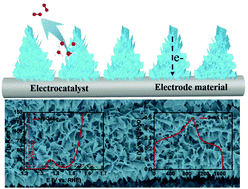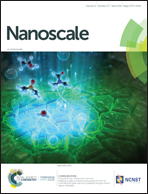Rational construction of self-supported triangle-like MOF-derived hollow (Ni,Co)Se2 arrays for electrocatalysis and supercapacitors†
Abstract
In this work, we have adopted a facile three-step method for constructing an intriguing bifunctional electrode of self-supported hollow (Ni,Co)Se2 arrays with a metal–organic framework (MOF) precursor. The triangle-like cobalt-based MOF arrays are first grown on a carbon cloth at room temperature, which is followed by an ion exchange/etching process with Ni(NO3)2 to form a critical hollow nanostructure with an incorporated hetero-metal element. The intermediate is then transformed into the final product through solvothermal selenization treatment. Taking advantages of the structural and compositional merits as well as the self-supporting nature, the resultant (Ni,Co)Se2 electrode exhibits excellent electrochemical activity and stability. When tested as an electrocatalyst for the oxygen evolution reaction (OER), the (Ni,Co)Se2 array electrode displayed a low onset overpotential of 226 mV and a small overpotential of 256 mV to afford a current density of 10 mA cm−2. The (Ni,Co)Se2 electrode is also utilized in a supercapacitor, which delivers a high specific capacitance of 2.85 F cm−2 at 2 mA cm−2 and exhibits excellent cycling stability with a capacitance retention of 80.8% after 2000 charge–discharge cycles at 20 mA cm−2. These results demonstrate the significance of the rational design of electrode materials and disclose the potential of our MOF-derived hollow (Ni,Co)Se2 array electrode for a variety of practical applications in energy conversion and storage.



 Please wait while we load your content...
Please wait while we load your content...